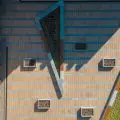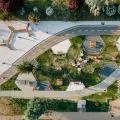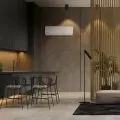Golden division of space
Reading the book "Composition of Space. Computation of space-time rhythm" is still as difficult today as it was years ago. On the other hand, it is extremely inspiring, stimulates the imagination, forces one to continue the creative search, and puts modernism in a new light. Picking it up from the deposit of history involves the discovery that Kobro and Strzeminski created the principle of composing space, which today we can call the golden division of space! By indicating the average human height of 175 cm as a module in the space-time rhythm of the shapes of space construction in the ratio of 8/513, they preceded the publication of "only" two-dimensional Modulor by Le Corbusier by 17 years!
They arrived at the innovative "golden division in space" by conducting complex analyses of sculpture, its relationship to space, to architecture. They analyzed the relationship between space and painting, the ways in which they are perceived by humans. Ultimately, the viewer, looking at open spatial sculptures, surrenders to their spatial influence, enters their interiors, penetrates them, "functionalizes" them, moves in the interiors guided by their shapes. Sculpture becomes an architecture that "....organizes the rhythm of human movement in space, requires a total relationship: the arrangement of utilitarian things, structural inventions, the quality of color and the direction of shapes, which themselves lift and guide the rhythm of human life in architecture. The source of harmony of rhythm is a measure derived from the number." They give the numerical ratio of 8/5, which belongs to the sequence of Fibonacci's golden number.
Kobro brought her talents as a sculptor and Strzeminski as a painter to the joint work. She worked on the concept of spatial sculptures for many years and creatively went further than K. Malevich, G. Vantongerloo, or van Doesburg. Strzeminski worked on the theory of vision. He argued that man sees with images14 and that the eye dynamically penetrates the environment. It remembers frames and shots of shapes from different directions. The appearance of various things is distorted, but this allows one to extract depth and feel space. Then the gaze goes beyond the frame, creates another and reads another image. After the previous one, its afterimages remain in memory.
The images change when one moves - so the depth and perception of space changes. It is perceived through movement within it. The interior reveals its successive proportions, properties, its composition is revealed. Kobro writes that the ensembles of human activities should pass from one to another in an "agreed manner," and the framing of form in a calculated space-time rhythm is the law that directs the process of passing from one set of shapes controlling movements to another set of shapes.15 We should add that the proportions of the golden ratio, read by juxtaposed frames, transfer from one to another through "afterimages." Here we discover their essential role in architecture. Images carried by this short memory juxtapose their elements, lines, planes, overlap in the process of emotional perception. The golden division emerges from among them as their glue, as a relationship between shapes that co-create space. This happens in a certain rhythm, and this rhythm is supposed to correspond to the harmony and nature of man, the logic of function - to consequently - guide the rhythm of life. This means that the space should be composed so that its reception occurs in rhythm, sequences at a certain time, so it should be composed according to the principle of this rhythm. They called this principle spatio-temporal rhythm16.
Strzeminski's theory of unionism and afterimages melted with Kobro's idea of spatial sculpture, into a single vision of the construction of architectural space.
The universal principle of space composition was found!
Janusz Zagrodzki, the discoverer of Kobro's work, attempted to explain the principles of spatial composition and the rhythm of dimensions. He mentioned that they lead to the proportions of the golden division17. However, it is necessary to state more. It is the basis of the harmony of her sculptures in a broader, new and multidimensional sense. Kobro's sculptures, through the rule of rhythm and division of space in a certain proportion, have a coded structure that expands, has no boundaries, passes from one arrangement to another, merges with unlimited space. It takes the user from place to place according to the rule, in which Kobro includes his predisposition, level of perception, psychological issues. Her concept relates, therefore, to the universal organization of life, the space of architecture, is a universal principle of composition, which they sought. Kobro wrote: "Theunity of composition is rhythm. The energy of consecutive shapes in space produces a space-time rhythm. The source of harmony of the rhythm is the measure resulting from the number. The task of spatial composition is the formation of forms, having an exit into life. Spatial composition is a laboratory study, determining the architecture of future cities. Spatial composition, becoming architecture, organizes the rhythm of human movements in space. Its rhythm of the artwork then becomes the rhythm of the movement of crowds and individuals. Spatialcomposition creates emotions. "18
Andrzej Turowski, in his analyses of Polish Constructivism and texts devoted to Kobro's work,19 marginally mentions the golden division, and fails to see that in Kobro and Strzeminski's work it is not a flat graph on a plane, but concerns multidimensional relations in which the fourth dimension is time. Bożena Kowalska asked whether Kobro was the first to use the mysterious phenomenon of golden division harmony in her sculptures to achieve "the consonance of all potential rhythms," to make visual art the equivalent of music?20 We can answer that yes, that the concept was and still is an international novelty.
Harmony and falsity
The golden division has inspired artists since ancient times. It has become an important canon in art. Kobro and Strzeminski postulate that its spatio-temporal rhythm should also be applied to the graphic composition of the printed page. Musicologists also see the existence of the Fibonacci sequence in musical works and in the construction of instruments. "Die Kunst der Fuge BWV 1080" by J. S. Bach is an example of the construction of musical structures in spatial arrangements that intertwine, their composition takes us from one into the other. Composers such as K. Stockhausen or L. Nono composed using it to organize rhythm or harmony, but many years after Kobro and Strzeminski. It no longer surprises us to find it in the structure of plants, ancient buildings, in Vitruvius or Leonardo da Vinci. We used to draw it on a plane, but now, after the achievements of "a.r." has been given the task for establishing multidimensional compositions in architectural space.
Harmony in music, created with a golden number avoids false sounds and tones. Will it produce a similar effect in architecture in the form of a space harmoniously composed for the diverse human perception of it? As early as 1928, Strzeminski and Syrkus wrote: "Thefunctionalism of space, permeating an architectural work, is a kind of note. In each house during the time for which that house is intended, everyday life is played out according to these notes." We have, then, a combination of harmony of space and harmony of function. The association of architecture with dynamics and the utilitarian vitality of its perception directs us to the various spatial phenomena around man, as their recipient, with the need to look at architecture from this perspective. This confronts us with the task that from now on we should not compose facades, structural structures or the plan of a building according to the rules of image, but they should become a record of impressions and composition of the rhythm of life inside the space they determine to release the emotions of architecture. They are to be the result of the golden harmony of the user's rhythm of life with the harmony of the rhythm of shapes, textures and colors.
Synergy of different art disciplines
Also, color in the composition of space by Kobro and Strzeminski plays a fundamental role. "By introducing color into a solid, we break it up. Color dematerializes the solid. From a material body it becomes an expression of purely spatial relations. "21 Color creates its own compositional arrangements, but one should not use a range of colors, because this one binds the solid together, one must use contrasting colors that open it up to its surroundings. "Color tames the space and radiates into it. The greater the tension of the color, the more forcefully it exerts its influence on the space, subjecting it to the action of its energy, going out of the sculpture into the space, opening in the space the range of influence of the sculpture. Theenergy of color, while breaking up the solid, at the same time connects the sculpture to the space. "22 These are further advances of the avant-garde that challenge the established stereotypes of modernist architecture of gray concrete or white walls, where only chiaroscuro emphasized the solid.
Architects, working with artists, pointed out to them places for sculptures and plane frames for paintings and mosaics. Kobro and Strzeminski, on the other hand, combine different fields of art into a whole spatial phenomenon. They point out the close relationship and interpenetration of painting, sculpture and architecture, and extend it to poetry and music. There is a smooth transition of dependencies, principles and compositional relationships from one to the other. Their analysis is a difficult task for art criticism, inclined to systematization and distance. To grasp the scales of these phenomena, one needs to participate in the creative act or read their output from the perspective of the creator's struggle. Personal perception and, from this perspective, the experience of the impact of architecture on people's lives, rather than considering style within the framework of established notions of aesthetics, takes on new importance. In view of the depth and variety of the types of phenomena encompassed by the composition of space and its multidimensional golden division, Corbuisier's Modulor seems to be just a scale - a ruler at which drawings are drawn.
Taking up the legacy of modernism from the depository of history
Let's pick up the thread dropped by the Polish avant-garde. Its achievements inspire a redefinition of architecture and a new approach to preserving the monuments of modernism.
Architecture can be defined as the emotion produced by the forms of space in which their user - the viewer - finds himself. The feeling of emotion is an internal property of man, not the built structure of buildings and their layouts. It always flows from within and a person is always inside something. One cannot be "outside" the space one is in. One is always moving from one interior layout to another. Since architecture is an emotion it does not exist without the viewer. You can't get away from it because it is created in us through multi-sensory perception of the environment.
This definition changes the perspective of design. Architecture cannot be created from a distance, capturing buildings as solids with their relationship to the environment. The architect is a composer of the emotions he wants to trigger in the viewer. This is a different attitude from the commonly held conviction that architecture is the shape of a building and its appearance, that architecture is a solid that has a structure and elevations, represents a certain style, realizes certain functional functions. Designing from a distance makes the designer play the main role. Then, instead of the harmony and order felt by the viewer, we have the emotion and fascination of the creative architect, who, looking from the outside at the mock-up from different directions, designs elevations, draws projections and sections23, models. He positions himself outside the space he is designing. He creates a solid of more or less complex shape and, like a manufactured thing, sells it for use, the enjoyment of the functions offered. Kobro and Strzeminski, on the other hand, position the creator and the viewer inside the space. From this place it is to be designed, because from this place it is received. Here is the place of reference around which it should be composed in a space-time rhythm.
Infinite strings of numbers
Today the rhythm of life is set by infinite strings of numbers, among which the basic one is the binary code used in computer technology. Numbers are triumphing. Has the dream of the avant-garde come true? Computer technology makes it possible to create virtual models of houses and cities, take walks in them, track views, simulate the sun. However, the project is still the work of an architect, who uses an intellectually defined creative method and has a specific workshop. In view of the epochal accelerated development of various fields of life, science, the inability to grasp them, architects limit the workshop to intuition. Works are created that, in place of the harmony and order necessary for the community, offer the emotion and fascination of the architect of the creator, who, with his individuality, wants to distinguish his work from the background created by others.
The Real Avant-Garde ("a. r.") proposed humility towards history and man, submission, harmonization with his scale, proportions and dimensions. It proposed service, deep cognition of the addressee of creativity. Returning now to the harmony of space-time rhythm, we return to man. The avant-garde saw the common good, the common order, which are always perceived from an individual perspective. Now the individual perspective of the creator imposes his individual point of view on the audience, treated as a gray mass. It is, therefore, often dismissed as alien, and despite the powerful diversity on offer, it is incoherent, structurally illogical, and offers superficial, short-lived emotions of otherness. It lacks heart and human spirit. Syrkus' statement that once the ornamentation, the facade cladding, is reflected, a clumsy skeleton is revealed is still valid, showing what a game of appearances modern architecture represents, and how low and limited the sensibility of its creator was.
A new approach to preserving the monuments of modernism
Learning about the vision of architecture offered by the Polish avant-garde, we realize that modernist architecture did not cross the threshold of opening the solid. The creation of solids and thinking with solids - remained. The dynamism of the era, did not find its reflection in the dynamic, filled with movement on a human scale, a new revolutionary approach to architecture in the concepts of "a.r." Modernist dynamism was most fully externalized in house factories and the use of prefabricated elements. Realized from steel, glass and concrete, the buildings were cuboids or a composition from the juxtaposition or interpenetration of the simple solids of the cube, cylinder, cone. Architecturally, some of them were interesting only during construction, in their raw state, until their solids were closed with facade walls. The structure of the structure gave some tension in spatial relationships, excitement in anticipation of the final result and the experience of disappointment.
The basic first principle for the exposition of modernism is the opening of the masses. The masses of buildings, according to Syrkus' postulate, can be opened, and then, according to the method of Kobro and Strzeminski, recomposed in a space-time rhythm. This is the second principle. This is how to show the modernist spirit. Renovating buildings according to the original deprives them of traces left by the user, deprives them of the evidence of life and its rhythm. Leave, therefore, all traces of alterations, installations. This approach realizes the main slogan of modernism - "form follows function". The function shows how it formed the architecture of the building during its history. Let's preserve and protect history, let's not obliterate its traces. In this way, the beauty of the structure can be brought out, and by showing it partly in its raw state, we also show the achievements of construction technology.



















































